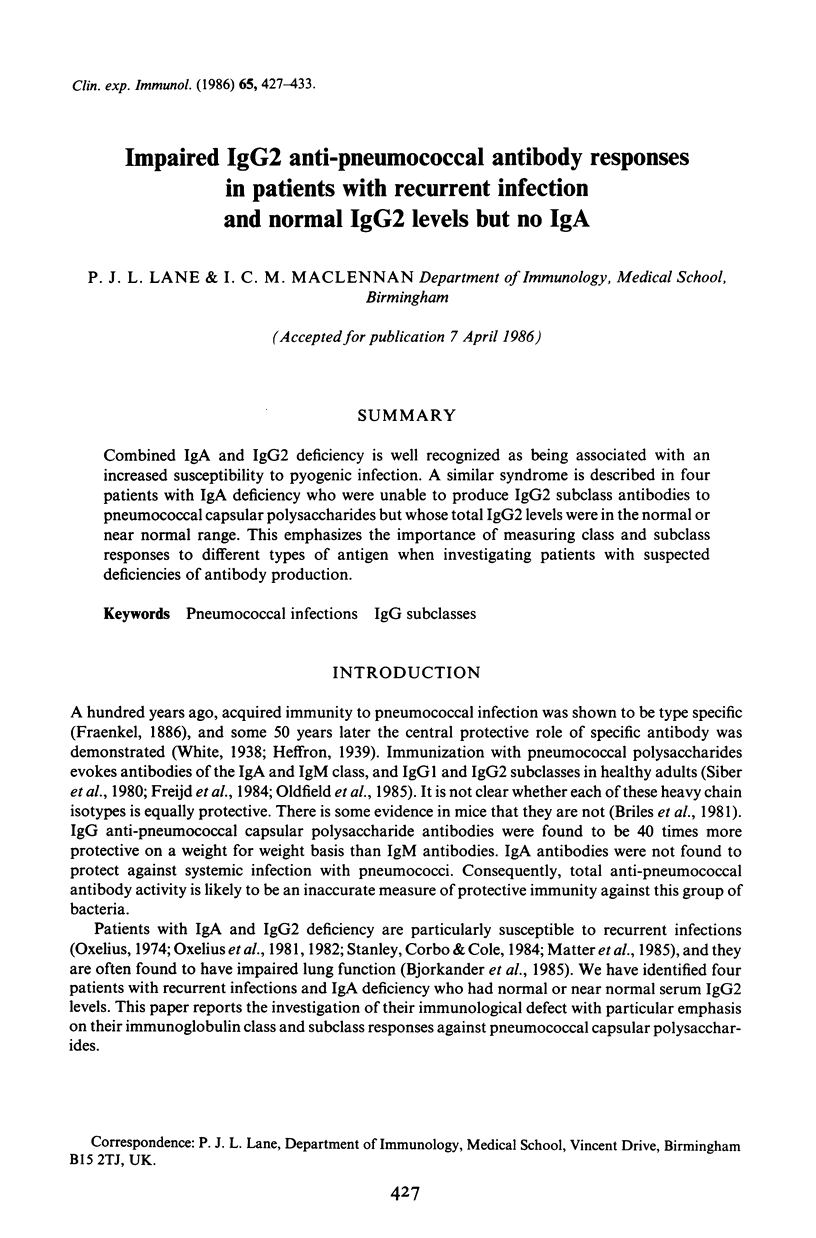Abstract
Combined IgA and IgG2 deficiency is well recognized as being associated with an increased susceptibility to pyogenic infection. A similar syndrome is described in four patients with IgA deficiency who were unable to produce IgG2 subclass antibodies to pneumococcal capsular polysaccharides but whose total IgG2 levels were in the normal or near normal range. This emphasizes the importance of measuring class and subclass responses to different types of antigen when investigating patients with suspected deficiencies of antibody production.
Full text
PDF






Selected References
These references are in PubMed. This may not be the complete list of references from this article.
- Ammann A. J., Hong R. Selective IgA deficiency: presentation of 30 cases and a review of the literature. Medicine (Baltimore) 1971 May;50(3):223–236. [PubMed] [Google Scholar]
- Anderson P., Pichichero M., Insel R., Farsad P., Santosham M. Capsular antigens noncovalently or covalently associated with protein as vaccines to Haemophilus influenzae type b: comparison in two-year-old children. J Infect Dis. 1985 Sep;152(3):634–636. doi: 10.1093/infdis/152.3.634. [DOI] [PubMed] [Google Scholar]
- BRUTON O. C. Agammaglobulinemia. Pediatrics. 1952 Jun;9(6):722–728. [PubMed] [Google Scholar]
- Björkander J., Bake B., Oxelius V. A., Hanson L. A. Impaired lung function in patients with IgA deficiency and low levels of IgG2 or IgG3. N Engl J Med. 1985 Sep 19;313(12):720–724. doi: 10.1056/NEJM198509193131203. [DOI] [PubMed] [Google Scholar]
- Borgoño J. M., McLean A. A., Vella P. P., Woodhour A. F., Canepa I., Davidson W. L., Hilleman M. R. Vaccination and revaccination with polyvalent pneumococcal polysaccharide vaccines in adults and infants. Proc Soc Exp Biol Med. 1978 Jan;157(1):148–154. doi: 10.3181/00379727-157-40010. [DOI] [PubMed] [Google Scholar]
- Briles D. E., Claflin J. L., Schroer K., Forman C. Mouse Igg3 antibodies are highly protective against infection with Streptococcus pneumoniae. Nature. 1981 Nov 5;294(5836):88–90. doi: 10.1038/294088a0. [DOI] [PubMed] [Google Scholar]
- Cowan M. J., Ammann A. J., Wara D. W., Howie V. M., Schultz L., Doyle N., Kaplan M. Pneumococcal polysaccharide immunization in infants and children. Pediatrics. 1978 Nov;62(5):721–727. [PubMed] [Google Scholar]
- Eskola J., Käyhty H., Peltola H., Karanko V., Mäkelä P. H., Samuelson J., Gordon L. K. Antibody levels achieved in infants by course of Haemophilus influenzae type B polysaccharide/diphtheria toxoid conjugate vaccine. Lancet. 1985 May 25;1(8439):1184–1186. doi: 10.1016/s0140-6736(85)92863-6. [DOI] [PubMed] [Google Scholar]
- Feehally J., Brenchley P. E., Coupes B. M., Mallick N. P., Morris D. M., Short C. D. Impaired IgG response to tetanus toxoid in human membranous nephropathy: association with HLA-DR3. Clin Exp Immunol. 1986 Feb;63(2):376–384. [PMC free article] [PubMed] [Google Scholar]
- Freijd A., Hammarström L., Persson M. A., Smith C. I. Plasma anti-pneumococcal antibody activity of the IgG class and subclasses in otitis prone children. Clin Exp Immunol. 1984 May;56(2):233–238. [PMC free article] [PubMed] [Google Scholar]
- Granoff D. M. Pneumococcal vaccine in children. Clin Pediatr (Phila) 1980 Feb;19(2):96–98. doi: 10.1177/000992288001900203. [DOI] [PubMed] [Google Scholar]
- Gray D., Chassoux D., MacLennan I. C., Bazin H. Selective depression of thymus-independent anti-DNP antibody responses induced by adult but not neonatal splenectomy. Clin Exp Immunol. 1985 Apr;60(1):78–86. [PMC free article] [PubMed] [Google Scholar]
- Hammarström L., Axelsson U., Björkander J., Hanson L. A., Möller E., Smith C. I. HLA antigens in selective IgA deficiency: distribution in healthy donors and patients with recurrent respiratory tract infections. Tissue Antigens. 1984 Jul;24(1):35–39. doi: 10.1111/j.1399-0039.1984.tb00395.x. [DOI] [PubMed] [Google Scholar]
- Holt P. D., Tandy N. P., Anstee D. J. Screening of blood donors for IgA deficiency: a study of the donor population of south-west England. J Clin Pathol. 1977 Nov;30(11):1007–1010. doi: 10.1136/jcp.30.11.1007. [DOI] [PMC free article] [PubMed] [Google Scholar]
- Lowe J., Bird P., Hardie D., Jefferis R., Ling N. R. Monoclonal antibodies (McAbs) to determinants on human gamma chains: properties of antibodies showing subclass restriction or subclass specificity. Immunology. 1982 Oct;47(2):329–336. [PMC free article] [PubMed] [Google Scholar]
- Matter L., Wilhelm J. A., Angehrn W., Skvaril F., Schopfer K. Selective antibody deficiency and recurrent pneumococcal bacteremia in a patient with Sjögren's syndrome, hyperimmunoglobulinemia G, and deficiencies of IgG2 and IgG4. N Engl J Med. 1985 Apr 18;312(16):1039–1042. doi: 10.1056/NEJM198504183121607. [DOI] [PubMed] [Google Scholar]
- Oldfield S., Jenkins S., Yeoman H., Gray D., MacLennan I. C. Class and subclass anti-pneumococcal antibody responses in splenectomized patients. Clin Exp Immunol. 1985 Sep;61(3):664–673. [PMC free article] [PubMed] [Google Scholar]
- Oxelius V. A., Berkel A. I., Hanson L. A. IgG2 deficiency in ataxia-telangiectasia. N Engl J Med. 1982 Mar 4;306(9):515–517. doi: 10.1056/NEJM198203043060905. [DOI] [PubMed] [Google Scholar]
- Oxelius V. A. Chronic infections in a family with hereditary deficiency of IgG2 and IgG4. Clin Exp Immunol. 1974 May;17(1):19–27. [PMC free article] [PubMed] [Google Scholar]
- Oxelius V. A. IgG subclass levels in infancy and childhood. Acta Paediatr Scand. 1979 Jan;68(1):23–27. doi: 10.1111/j.1651-2227.1979.tb04424.x. [DOI] [PubMed] [Google Scholar]
- Oxelius V. A., Laurell A. B., Lindquist B., Golebiowska H., Axelsson U., Björkander J., Hanson L. A. IgG subclasses in selective IgA deficiency: importance of IgG2-IgA deficiency. N Engl J Med. 1981 Jun 11;304(24):1476–1477. doi: 10.1056/NEJM198106113042408. [DOI] [PubMed] [Google Scholar]
- Schur P. H., Rosen F., Norman M. E. Immunoglobulin subclasses in normal children. Pediatr Res. 1979 Mar;13(3):181–183. doi: 10.1203/00006450-197903000-00010. [DOI] [PubMed] [Google Scholar]
- Scott M. G., Fleischman J. B. Preferential idiotype-isotype associations in antibodies to dinitrophenyl antigens. J Immunol. 1982 Jun;128(6):2622–2628. [PubMed] [Google Scholar]
- Shann F., Gratten M., Germer S., Linnemann V., Hazlett D., Payne R. Aetiology of pneumonia in children in Goroka Hospital, Papua New Guinea. Lancet. 1984 Sep 8;2(8402):537–541. doi: 10.1016/s0140-6736(84)90764-5. [DOI] [PubMed] [Google Scholar]
- Siber G. R., Schur P. H., Aisenberg A. C., Weitzman S. A., Schiffman G. Correlation between serum IgG-2 concentrations and the antibody response to bacterial polysaccharide antigens. N Engl J Med. 1980 Jul 24;303(4):178–182. doi: 10.1056/NEJM198007243030402. [DOI] [PubMed] [Google Scholar]
- Stanley P. J., Corbo G., Cole P. J. Serum IgG subclasses in chronic and recurrent respiratory infections. Clin Exp Immunol. 1984 Dec;58(3):703–708. [PMC free article] [PubMed] [Google Scholar]


